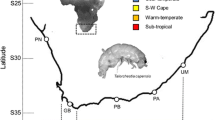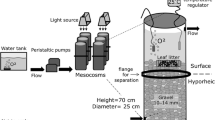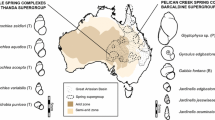Abstract
In the maritime Antarctic, terrestrial arthropods have recourse to two strategies to mitigate low summer temperatures: (1) physiological plasticity and (2) avoidance via microhabitat insulation. This study investigated the interaction between these strategies in the springtail, Cryptopygus antarcticus, established in situ within contrasting microcosms (buffered vs. exposed) and within two sets of habitat simulations (wet vs. dry) over diurnal scales through the Antarctic summer. Significant differences were found in the cold hardiness of springtails sampled simultaneously from each microcosm. Exposed animals showed greater plasticity in the “true” austral summer, but as field temperatures declined preceding the onset of winter, buffered animals showed greater resilience. Overall, water was found to inhibit the buffering effect of moss and there was a significantly greater discrimination between buffered and exposed microcosms in the dry treatment. Analysis of microhabitat temperatures indicate that it is thermal variability not lower temperature that is responsible for the greater plasticity of exposed animals.



Similar content being viewed by others
References
Addo-Bediako A, Chown SL, Gaston KJ (2000) Thermal tolerance, climatic variability and latitude. Proc R Soc Lond B 267:739–745
Bale JS (1991) Insects at low temperature: a predictable relationship? Funct Ecol 5:291–298
Bale JS (2002) Insects and low temperatures: from molecular biology to distribution and abundance. Philos Trans R Soc Lond B 357:849–862
Beck SD (1991) Thermoperiodism. In: Lee RE, Denlinger DL (eds) Insects at low temperature. Chapman and Hall, London, pp 199–228
Block W (1996) Cold or drought––the lesser of two evils for terrestrial arthropods? Eur J Entomol 93:325–339
Block W, Sømme L (1982) Cold hardiness of terrestrial mites at Signy Island, maritime Antarctic. Oikos 38:157–167
Burn AJ (1981) Effects of temperature on the feeding activity of Cryptopygus antarcticus. Comité National Français Des Recherches Antarctiques 51:209–216
Burn AJ (1984) Life cycle strategies in two Antarctic Collembola. Oecologia 64:223–229
Burn AJ, Lister A (1988) Activity patterns in an Antarctic arthropod community. Br Antarct Surv Bull 78:43–48
Cannon RJC, Block W (1988) Cold tolerance of microarthropods. Biol Rev 63:23–77
Convey P (1996) The influence of environmental characteristics on life history attributes of Antarctic terrestrial biota. Biol Rev 71:191–225
Coulson SJ, Hodkinson ID, Strathdee AT, Block W, Webb NR, Bale JS, Worland MR (1995) Thermal environments of Arctic soil organisms during winter. Arct Alp Res 27:364–370
Coulson SJ, Leinaas HP, Ims RA, Søvik G (2000) Experimental manipulation of the winter surface ice layer: the effects on a High Arctic soil microarthropod community. Ecography 23:299–306
Danks HV (1978) Modes of seasonal adaptation in the insects. I. Winter survival. Can Entomol 110:1167–1205
Danks HV (1981) Arctic Arthropods. Entomological Society of Canada, Ottawa
Danks HV (1991) Winter habitats and ecological adaptations for winter survival. In: Lee RE, Denlinger DL (eds) Insects at low temperature. Chapman and Hall, London, pp 231–259
Davey MC, Pickup J, Block W (1992) Temperature variation and its biological significance on a maritime Antarctic island. Antarct Sci 4:383–388
Doughty P, Reznick DN (2004) Patterns and analysis of adaptive phenotypic plasticity in animals. In: DeWitt TJ, Scheiner SM (eds) Phenotypic Plasticity Functional and Conceptual Approaches. Oxford University Press, Oxford, pp 126–150
Geiger R (1965) The climate near the ground. Harvard University Press, Cambridge
Hawes TC, Bale JS (2007) Plasticity in arthropod cryotypes. J Exp Biol 210:2585–2592
Hawes TC, Bale JS, Worland MR, Convey P (2006a) Ecologically realistic modalities in arthropod supercooling point distributions. Eur J Entomol 103:717–723
Hawes TC, Couldridge CE, Bale JS, Worland MR, Convey P (2006b) Habitat temperature and the temporal scaling of cold hardening in the High Arctic collembolan, Hypograstrura tullbergi (Schäffer). Ecol Entomol 31:450–459
Hawes TC, Bale JS, Worland MR, Convey P (2007a) Plasticity and superplasticity in the Antarctic mite Halozetes belgicae (Michael). J Exp Biol 210:593–601
Hawes TC, Bale JS, Worland MR, Convey P (2007b) Moulting reduces freeze susceptibility in the Antarctic mite Alaskozetes antarcticus (Michael). Physiol Entomol. doi:10.1111/j.1365-3032.2007.00547
Hawes TC, Worland MR, Bale JS, Convey P (2007c) Aerial dispersal of springtails on the Antarctic Peninsula: implications for local distribution and demography. Antarct Sci 19:3–10
Hayward SAL, Worland MR, Convey P, Bale JS (2004) Habitat moisture availability and the local distribution of the Antarctic Collembola Cryptopygus antarcticus and Friesea grisea. Soil Biol Biochem 36:927–934
Hertzberg K (1997) Migration of Collembola in a patchy environment. Pedobiol 41:494–505
Hertzberg K, Leinaas HP (1998) Drought stress as a mortality factor in two pairs of sympatric species of Collembola at Spitsbergen, Svalbard. Polar Biol 19:302–306
Hodkinson ID, Webb NR, Bale JS, Block W (1999) Hydrology, water availability and tundra ecosystem function in a changing climate: the need for a closer integration of ideas? Glob Change Biol 5:359–369
Hopkin SP (1997) Biology of the Springtails. Oxford University Press, Oxford
Irwin JT, Lee RE (2003) Cold winter microenvironments conserve energy and improve overwintering survival and potential fecundity of the goldenrod gall fly, Eurosta solidaginis. Oikos 100:71–78
Lee RE, Chen CP, Denlinger DL (1987) A rapid cold-hardening process in insects. Science 238:1415–1417
Kennedy AD (1993) Water as a limiting factor in the Antarctic terrestrial environment: a biogeographical synthesis. Arctic Alp Res 25:308–315
Mani MS (1962) Introduction to High Altitude Entomology. Methuen & Co, London
Pryor ME (1962) Some environmental features of Hallett Station, Antarctica, with special reference to soil arthropods. Pac Insects 4:681–728
Schenker R, Block W (1986) Micro-arthropod activity in three contrasting terrestrial habitats on Signy Island, Maritime Antarctic. Brit Antarct Surv Bull 71:1–43
Shreve SM, Kelty JD, Lee RE (2004) Preservation of reproductive behaviours during modest cooling: rapid cold-hardening fine-tunes organismal response. J Exp Biol 207:1797–1802
Sinclair BJ, Addo-Bediako A, Chown SL (2003) Climatic variability and the evolution of insect freeze tolerance. Biol Rev 78:181–195
Sømme L, Block W (1982) Cold-hardiness of Collembola at Signy Island, maritime Antarctic. Oikos 38:168–76
Strathdee AT, Bale JS (1995) Factors limiting the distribution of Acyrthosiphon svarlbardicum (Hemiptera, Aphididae) on Spitsbergen. Polar Biol 15:375–380
Tilbrook PJ (1967) Arthropod Ecology in the Maritime Antarctic. Antarct Res Ser 10:331–356
Turnock WJ, Fields PG (2005) Winter climates and cold hardiness in terrestrial insects. Eur J Entomol 102:561–576
Walton DWH (1982) The Signy Island terrestrial reference sites. XV. Microclimate monitoring, 1972–4. Brit Antarct Surv Bull 55:111–126
Worland MR (2005) Factors that influence the supercooling point of the sub-Antarctic springtail Tullbergia antarctica. J Insect Physiol 51:881–894
Worland MR, Convey P (2001) Rapid cold hardening in Antarctic microarthropods. Funct Ecol 15:515–524
Worland MR, Hawes TC, Bale JS (2007) Temporal resolution of cold acclimation and de-acclimation in the Antarctic collembolan, Cryptopygus antarcticus. Physiol Entomol 32:233–239
Acknowledgments
TCH was funded by BBSRC. The NERC Antarctic Funding Initiative (CGS6/13) funded fieldwork at Rothera Research Station. Prof Ian Hodkinson and two anonymous referees are thanked for their constructive criticism of the ms.
Author information
Authors and Affiliations
Corresponding author
Rights and permissions
About this article
Cite this article
Hawes, T.C., Bale, J.S., Worland, M.R. et al. Trade-offs between microhabitat selection and physiological plasticity in the Antarctic springtail, Cryptopygus antarcticus (Willem). Polar Biol 31, 681–689 (2008). https://doi.org/10.1007/s00300-008-0406-3
Received:
Revised:
Accepted:
Published:
Issue Date:
DOI: https://doi.org/10.1007/s00300-008-0406-3




